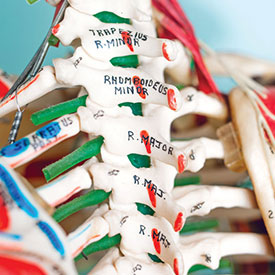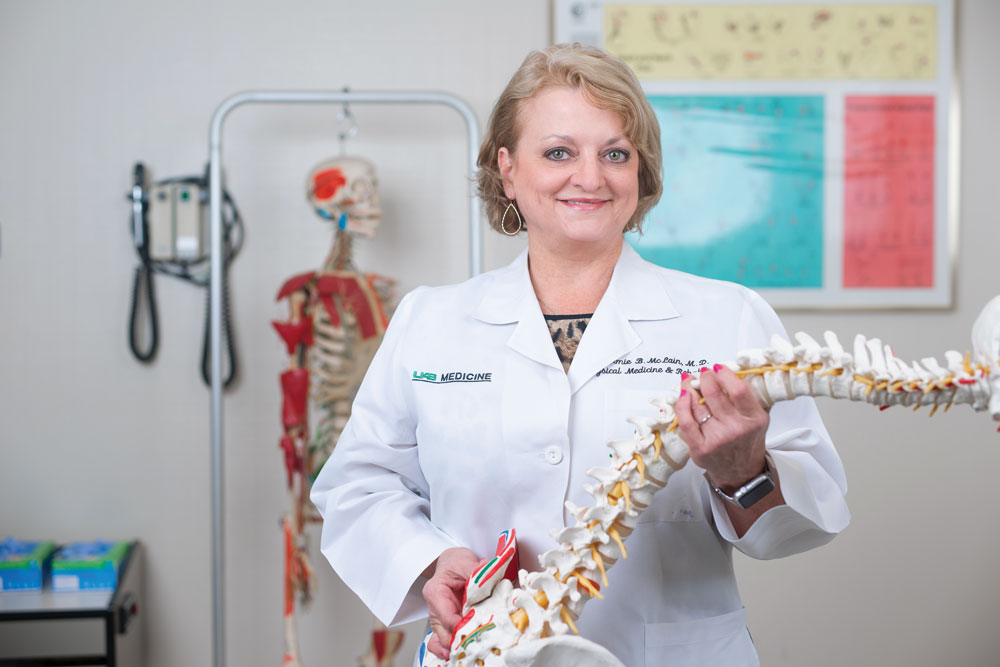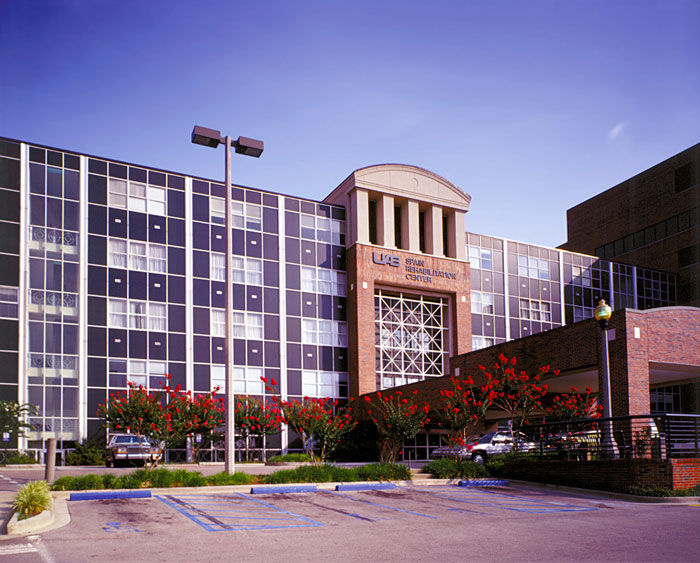 UAB’s Spinal Cord Injury Model System is one of only 14 officially recognized systems in the country and the longest continually funded SCI model system in existence.Prior to her residency in physical medicine and rehabilitation at UAB, Amie Brown (Jackson) McLain, M.D., witnessed her father suffer a spinal cord injury and become paralyzed after cancer spread into his bones. “It was very traumatic,” McLain says. “At that time I was not very knowledgeable at all about his condition, or what could or should be done. He lived several years with his paralyses. Having seen it at a certain age in my life made a profound impression on me.”
UAB’s Spinal Cord Injury Model System is one of only 14 officially recognized systems in the country and the longest continually funded SCI model system in existence.Prior to her residency in physical medicine and rehabilitation at UAB, Amie Brown (Jackson) McLain, M.D., witnessed her father suffer a spinal cord injury and become paralyzed after cancer spread into his bones. “It was very traumatic,” McLain says. “At that time I was not very knowledgeable at all about his condition, or what could or should be done. He lived several years with his paralyses. Having seen it at a certain age in my life made a profound impression on me.”
Today McLain is chair of the Department of Physical Medicine and Rehabilitation, holder of the Robert B. Kyle Professorship and Chair in Rehabilitation Medicine, and director of the UAB Spinal Cord Injury (SCI) Model System. UAB’s SCI Model System is one of only 14 officially recognized systems in the country and the longest continually funded SCI model system in existence. UAB is also home to the National Spinal Cord Injury Statistical Center (NSCISC), directed by Yuying Chen, M.D., Ph.D., which supports and directs the collection, management, and analysis of the world’s largest spinal cord injury research database. Both programs are funded every five years by the National Institute on Disability, Independent Living, and Rehabilitation Research (NIDILRR).
McLain describes the model system as a patient-centered program designed to follow people with SCI throughout their lives. It is a way to identify patterns in the common health problems, or secondary conditions, that this unique population faces. “We look at what’s going on to ask the questions, Why are we seeing this? How can we get around it and do something better?” explains McLain.
Much of the progress made through the SCI model system is gradual, but there are occasional breakthroughs. McLain recalls that one patient suffering from recurring skin problems, including pressure sores, ended up having the connective tissue disorder scleroderma. That case, McLain notes, is an example of what happens all too often with SCI patients. Since skin problems are a common secondary condition associated with SCI, doctors might prematurely rule out possibilities unrelated to SCI. In other cases, patients who come in with relatively common conditions may be improperly diagnosed because their symptoms are different than those of people without SCI.
 Amie McLain chairs the Department of Physical Medicine and Rehabilitation.The NSCISC is helping alleviate these problems by making its vast trove of data—the combined knowledge gathered from all the nation’s model systems—available to health care professionals both inside and outside the rehabilitation field. Chen says the importance of having a national statistical center is hard to overestimate when it comes to improving care for those with SCI. “Our main focus is the support of research data collection,” Chen says. “The knowledge-translation part is making it accessible to anyone who is interested in data analysis, so we have an open policy for researchers to utilize it for their research.”
Amie McLain chairs the Department of Physical Medicine and Rehabilitation.The NSCISC is helping alleviate these problems by making its vast trove of data—the combined knowledge gathered from all the nation’s model systems—available to health care professionals both inside and outside the rehabilitation field. Chen says the importance of having a national statistical center is hard to overestimate when it comes to improving care for those with SCI. “Our main focus is the support of research data collection,” Chen says. “The knowledge-translation part is making it accessible to anyone who is interested in data analysis, so we have an open policy for researchers to utilize it for their research.”
Chen points out that the center also collects information that can be used in SCI prevention efforts as well as treatment. Many are unaware, for instance, that growing numbers of elderly people are now sustaining spinal cord injuries from falls. “We need to be aware of that because the data can forecast trends and shape where prevention efforts should be focused,” Chen says.
A New Way of Living
Phillip Klebine has been living with tetraplegia since he was injured in a car accident in 1984. He was brought to UAB for acute trauma care and eventually transferred to Spain Rehabilitation Center, where he began to come to terms with the fact that he would never walk again. “I knew that my body wasn’t going to work for me in the same way, so my mind had to,” Klebine says. He later enrolled as a student at UAB and earned an undergraduate degree in communication and a graduate degree in counseling. He began working at UAB and eventually became director of knowledge translation in the Department of Physical Medicine and Rehabilitation. “They wanted someone who had spinal cord injury, knew about it, and could write about secondary conditions related to spinal cord injury,” he says.
As someone living with SCI and working in UAB’s SCI programs, Klebine has had a uniquely close-up view of the progress that has been made in the field thanks in part to the SCI model system network. But few people with SCI know about the UAB model system, the statistical center, or how either has benefitted them. For example, conditions like urinary tract infections that are highly treatable now could lead to renal complications, kidney failure, and often death for people with SCI before advances occurred thanks in part to the model system and statistical center. In fact, most individuals with paraplegia and quadriplegia live healthy lives, adjusting far better to life after injury than many might assume.
Melissa Fendley is one of those people. Like Klebine, she suffered an SCI in a car accident in the ’80s when she was a teenager. Post-injury, she got married and had a child. She describes herself as very independent and notes her biggest health challenge was not her own but that of her husband, who was diagnosed with early-onset Alzheimer’s disease when he was 55. He passed away in January.
Fendley does not complain about having a spinal cord injury, but she says she appreciates not feeling alone when she comes for follow-up visits at UAB. “It’s good to know you’re not the only one going through this, even though we may all react to these injuries differently,” Fendley says. “It’s nice to have someone to lean on and talk to and bounce ideas off.”
That attitude of collaboration and perseverance permeates through the UAB SCI program patients and health care professionals. “The one thing that most people don’t understand or don’t think about is that spinal cord injury is only one obstacle,” Klebine says. “Granted, it’s a life-changing one, but people in general are very resilient and most do very well.”
By Rosalind Fournier
Support SystemThe Women’s Committee of the Spain Rehabilitation Center was formed in 1970 with a mission to improve quality of life for the center’s patients. Today, its impact can be seen throughout the center, which serves as the hub of activities for the Department of Physical Medicine and Rehabilitation (PM&R). Whether purchasing equipment, increasing public awareness of the center through charity events, or donating dozens of works of art that are displayed throughout the facility, the Women’s Committee has been Spain Rehab’s strongest and most loyal philanthropic supporter. The Women’s Committee has made numerous gifts to the facility over the decades that include a tilt table for the physical therapy department, funds to build a therapeutic pool, a wheelchair seating pressure monitor system, a diagnostic balance system, and a handicapped-accessible driver training van. These gifts are in addition to the $1 million the group raised to establish the Women’s Committee of the Spain Rehabilitation Center Endowed Chair in Rehabilitation Research.
“The Women’s Committee’s most recent purchases for the center include the Bioness Integrated Therapy System, a touch-screen tool to improve cognitive and balance training and hand-eye coordination; a bladder scanner making possible bedside evaluations; and a cryostat, an important research tool,” says Suzanne Payne, president of the Women’s Committee. “Our members are committed to supporting this vital part of the UAB system because we believe not only are the lives of the center’s patients changed as a result, but also those of patients all over the country who benefit from the center’s research.” |
